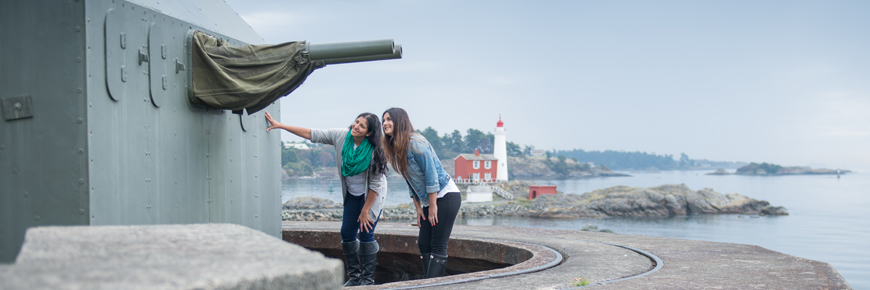
The twin-six gun overlooking the Juan de Fuca Straight.
The Evolution of Threats and Technology
Fort Rodd Hill and Fisgard Lighthouse National Historic Sites
The Batteries | The Guns of the Fort | Rifles and Machine Guns | The Small Arms and Hand Guns
Fort Rodd Hill is one of the only intact 19th century coastal military fortifications left in Canada. After years of being exposed to the harsh coastal weather, a restoration project was completed in a way that ensured the fort’s original features were kept as authentic as possible. For more information
Fort Rodd Hill was one of many forts constructed in the late 1800s as a Royal Marine Artillery coastal defense system. These forts existed to protect Victoria, and more importantly, Esquimalt Harbour. This is the home of Canada’s Pacific Naval Base, and during wartime, a thriving shipbuilding industry. Though the base was never attacked, protecting this key resource from a German or Japanese submarine or E-boat, or lurking motor torpedo boats, was necessary during WWI and WWII.
The three gun batteries on site housed artillery and their associated munitions, and the soldiers prepared to jump into action and operate them. As new war technology and tactics developed throughout the 20th century, the fort architecture and artillery in its batteries evolved.
By the 1950s, weapons like the atomic bomb and intercontinental ballistic missiles (ICBMs), which could strike with great precision from thousands of kilometers away, meant that the big guns of Fort Rodd Hill were simply outmatched and became obsolete. Fort Rodd Hill was decommissioned in 1956.
The Batteries
Three batteries can be found at Fort Rodd Hill: Upper Battery that sits high above the fort’s other structures; Lower Battery at the heart of the site; and the towering Belmont Battery. Constructed at vital vantage points, these three batteries tell stories of how technology at the fort changed and evolved through the World Wars and beyond.
Upper Battery
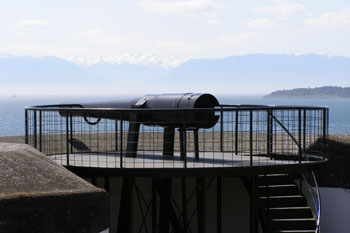
Not just a pretty viewpoint, the upper battery was constructed at a vital vantage point for coastal defence. Within the battery are the guardhouse, water tank, and underground magazine complex. Many people notice the weird, elbow-shaped growth formations of the trees near this battery. This is because trees were topped to give soldiers a clear line of sight when they fired the guns.
Lower Battery

At the center of Fort Rodd Hill is the lower battery, where the Canadian Red Ensign flag can be seen flying. Within its walls are the casemate barracks, constructed between 1895 and 1898, which in wartime could house 18 or 19 men per room. The battery’s defensible wall features loopholes from which soldiers could aim and shoot. Just outside, off-duty soldiers gathered at the Canteen where a cold brew was welcome.
Belmont Battery
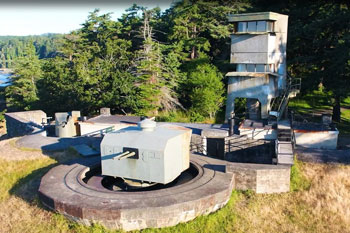
The only battery to undergo significant changes after its original construction, Belmont’s design distinguishes it from the other batteries. Originally completed in 1900, Belmont was equipped with two quick-firing guns that allowed it to target faster ships. During the Second World War, the concrete tower was built as a direction station and the guns were replaced by the more effective Twin 6-pounder.
The Guns of the Fort
During the Fort’s lifetime, the artillery that graced its fields and ramparts changed quite dramatically. Although none of these guns was ever fired upon an enemy at Fort Rodd Hill, weapons like these were used in battle from the time of the Boer War at the end of the 1890s to the Cold War. These weapons were not without their drawbacks. Time-consuming loading processes for certain artillery and malfunctioning firearms meant soldiers needed to be sharp and well-trained to operate them.
The Big Guns
Disappearing 6” Guns
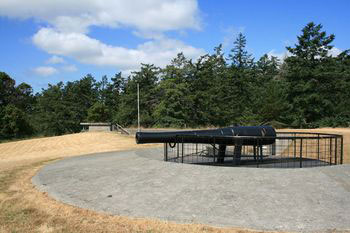
At the time of the Fort’s construction, these were high-tech weaponry. They used compressed air or steam to raise the barrel above the parapet to fire, then to lower it to safety below to be breech loaded. Today the mechanical ‘guts’ of these guns are gone, but you can still see one of the barrels in our upper battery.
Twin-barreled 6-pounder Guns
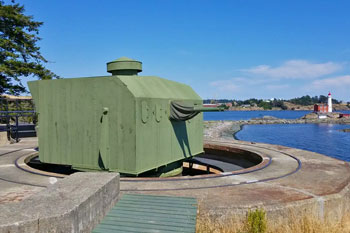
The Twin-barreled 6-pounder Gun that sits atop the Belmont Battery is a light coastal defence gun that was featured in forts like ours from the 1930s to the 1950s. They were designed to be mobile and quick enough to deal with fast-moving E-boats (Schnelboot in German) that could quickly sink convoys and disappear into the dark.
On their best day, teams of seven highly trained soldiers plus the members of the ammunition train could fire up to 72 rounds a minute; quite impressive given the rate of 15 rounds per minute that was averaged by the 12-pounder quick-firing gun that the Twin 6 replaced.
Quick-firing 12-pounder
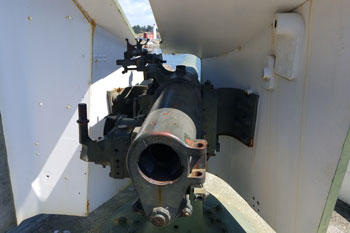
This Quick-firing 12-pounder was a common feature on British Naval Vessels and in fixed Coastal Defence systems from its introduction in 1894 until the middle of the 20th century. Fort Rodd Hill’s Belmont battery once featured two of them, but today we have one in place.
It fired a 12 lb projectile over 9 km and was specialized to defend against small, quick vessels like torpedo boats.
40mm Bofors Anti-aircraft (ACK ACK) Gun
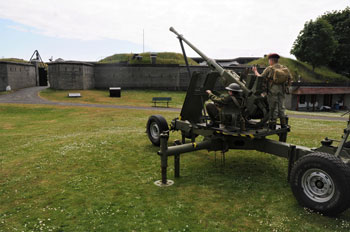
In the Second World War, threats were coming from the skies as well as the seas. Fear of attacks from above led to the installation of anti-aircraft weaponry. These anti-aircraft guns were of Swedish design (though Britain refined it for their own version), and were widely used during the Second World War. It could fire about 100 rounds per minute and was so important to the British defence system that around 19,000 of them had been manufactured in British, Canadian and Australian factories by the end of the war.
Rifles and Machine Guns
Martini-Henry Rifle

Used by the British across the Empire during the 19th century, the Martini-Henry Rifle (and its carbine versions) was familiar anywhere the British Army went, including here at Fort Rodd Hill. As the standard service rifle from 1874 until the 20th century, it was a single-shot, breech-loader riffle, which in skilled hands could fire more than 20 rounds per minute. Experienced troops learned to wrap the forestock with leather because it got very hot after repeated firing.
Canadian-made Ross Rifle
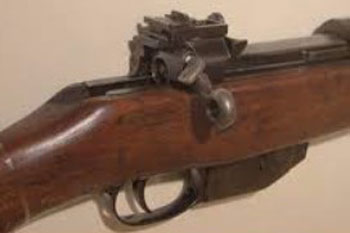
The notorious, Canadian-made Ross Rifle was manufactured between 1903 and 1918. Although popular as a sport rifle, and with an effective sniper model (as long as the ammunition was flawlessly clean), when it was distributed to the Canadian Expeditionary Force during the First World War it proved horribly unreliable for trench warfare due to its tendency to jam in muddy conditions, or to blow-up in the user’s face, or indeed for the bayonet to fall off when fired.
Bren Light Machine Gun
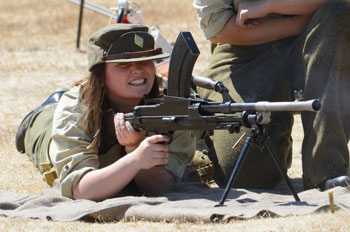
The Bren light machine gun is most commonly associated with the British Army during the Second World War but about 60% of Brens manufactured in the 1940s were made by John Inglis and Company, here in Canada. Although the barrels had a tendency to overheat, it was nonetheless highly effective, firing up to 500 rounds per minute of .303 caliber bullets, and accurate up to 550 m when shot from the prone position using the bipod.
Maxim Machine Gun

The Maxim Machine Gun was introduced into British service at the end of the 1800s; and soldiers at Fort Rodd Hill used these guns up to 1940. Prototypes for the gun, which were recognized as one of the first true machine guns, were produced as early as 1884. The gun weighed in at about 60 lbs and featured a water-cooled barrel to increase firing rate which allowed the gun to fire up to 400 rounds per minute at rapid-fire.
Fort Rodd Hill featured a number of machine gun positions on site to protect the fort from the threat of a landed infantry attack. The position at Lower Battery, seen above in about 1917, is still distinguishable today.
Sten submachine gun
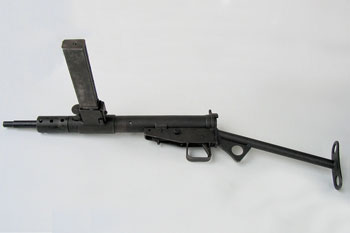
The Sten submachine gun was first designed by the British in 1941 as a cheap, interchangeable, lightweight gun to be carried by any infantry for whom short-range effectiveness was key. First used at Dieppe by Canadians, they were manufactured in Canada by the thousands. Intended as ‘throwaway’ weapons, they often jammed or accidentally discharged, making them unpopular with troops, but widely distributed. Some were even dropped by the SOE at night, piece by piece, into enemy-occupied France, to supply the Resistance movement.
The Small Arms and Hand Guns
WWI Webley Mk VI
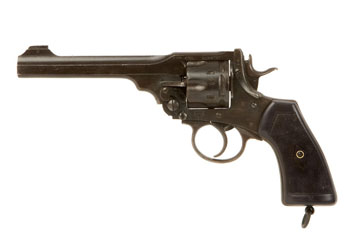
The WWI Webley Mk VI was adopted by the British in 1915 and distributed to officers, machine gun crews, tank crews and raiding parties. Though not standard issue for Canadian soldiers, they were often purchased by Canuck officers as their optional sidearm due to how robust their mechanisms were, and how their 6-round capacity could be enhanced by the Prideaux speed-loader to reduce loading times.
Drugs move big guns
30-ton Gun Drug Mk. 1
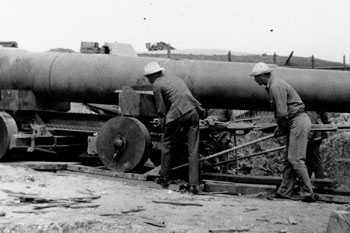
Positioned just below Upper Battery, adjacent to the entrance to the Garry Oak Learning Meadow, sits a display model of a 9.2” Breech loading gun on top of a cart known as a “Gun Drug.” Although the model gun barrel only weighs in at 2 tonnes, and original 9.2” gun would have weighed 30 tonnes, so the Gun Drug Mk. 1 was capable of carrying extremely heavy loads without the help of horses, oxen, or motorized vehicles. Even though Fort Rodd Hill was never home to guns as large and heavy as the 28-ton 9.2” guns, other defensive sites in the Victoria–Esquimalt Fortress, such as Signal Hill and Albert Head Batteries, had these guns mounted. The stout wheel base, steel-shod concrete wheels, and manually-operated winches allowed this cart to transport large loads to their destination.
- Date modified :